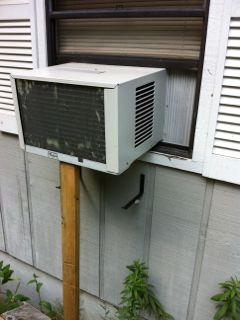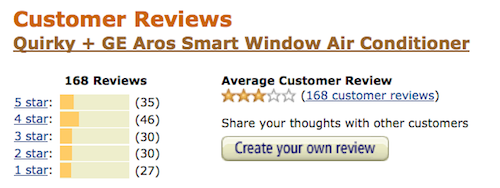Is the Aros Smart Window Air Conditioner Worth the Hype?

 When it comes to air conditioning, there are a lot of bad products and bad ideas out there. Here are a few: You can buy a cover for your condenser that could kill your compressor. Some people don’t think the outdoor unit really needs to go outdoors. (They’re wrong!) And then there’s the strange notion that attaching a kraken to your air conditioner is a good way to distribute the air. Today, though, I’m going to look at a product that’s not terrible.
When it comes to air conditioning, there are a lot of bad products and bad ideas out there. Here are a few: You can buy a cover for your condenser that could kill your compressor. Some people don’t think the outdoor unit really needs to go outdoors. (They’re wrong!) And then there’s the strange notion that attaching a kraken to your air conditioner is a good way to distribute the air. Today, though, I’m going to look at a product that’s not terrible.
When it comes to air conditioning, there are a lot of bad products and bad ideas out there. Here are a few: You can buy a cover for your condenser that could kill your compressor. Some people don’t think the outdoor unit really needs to go outdoors. (They’re wrong!) And then there’s the strange notion that attaching a kraken to your air conditioner is a good way to distribute the air. Today, though, I’m going to look at a product that’s not terrible.
Yes, I’m talking about the window air conditioner (also known as the room air conditioner or window shaker). I’ll discuss them in general first, but then I’ll take a look at a new product on the market, the Aros smart window air conditioner.
The story of window air conditioners
In the middle of the twentieth century, homes went from having no air conditioning to getting window air conditioners. The whole plot of the 1955 Marilyn Monroe movie, The Seven Year Itch, in fact, revolved around a window air conditioner. (And here’s a bit of trivia for you: It was in this movie that Marilyn Monroe had that famous subway breeze blowing her skirt up.) I experienced this myself when my grandparents first installed window units in their Leesville, Louisiana home in 1970.
Window air conditioners are perfectly fine in many respects. They allow you to do zone cooling in your home without worrying about pressure imbalances and bypass ducts. They can be less expensive to operate than a central air conditioner because you don’t have to keep the whole house at the same temperature. The many duct problems I’ve written about in this blog aren’t an issue because they have no ducts. And they’re a lot less expensive to install.
 They do have their drawbacks, however. The main one is noise. With the compressor sitting right there, separated from you by a little bit of plastic, metal, and filter, you won’t be listening to the birds sing outdoors. In fact, you may not hear the birds sing indoors, unless you have a really loud parrot or get really close. (But who keeps birds in their house anymore? I don’t think I’ve been to a home with birds in decades.)
They do have their drawbacks, however. The main one is noise. With the compressor sitting right there, separated from you by a little bit of plastic, metal, and filter, you won’t be listening to the birds sing outdoors. In fact, you may not hear the birds sing indoors, unless you have a really loud parrot or get really close. (But who keeps birds in their house anymore? I don’t think I’ve been to a home with birds in decades.)
Another drawback is the loss of use of the window you install the air conditioner in. You can no longer use it to cross ventilate for natural cooling, and it blocks natural light as well.
You need cooling
Sometimes, though, the drawbacks just don’t matter.
You need cooling. Baby, I’m not fooling. I’m gonna send you, Back to schooling.Ah, there goes my secret. Yes, I was a teenage boy in the ’70s. In fact, I recall listening to Led Zeppelin II one evening in the summer of ’77 on my 8 track tape player at my grandparents’ house as the window air conditioners were humming in the other rooms. (They had three.) I was writing a letter to no one in particular—and which, by the time I was done, I wanted no one to see. But that’s another story.
These days, most single family detached homes have central air conditioning. Even my grandparents’ house got it in the ’90s. Window air conditioners are more often used in big condo and apartment buildings at latitudes higher than where I’ve lived all but 7 years of my life (south of 39°). The DC area and north are where they prevail here in North America.
In a big building, it can be difficult to run refrigerant lines to install any kind of split system air conditioner. Locating the outdoor unit might be difficult or impossible as well, so if you want cooling, the window air conditioner is your answer.
Martin Holladay wrote a comprehensive article about window air conditioners a couple of years and concluded that they can save energy when used instead of central air conditioners. That’s debatable for us here in the humid Southeast, where it’s not all about cooling but controlling the humidity as well. Anyway, Martin discussed a lot of good stuff, including efficiency ratings and the difference between SEER, which is used for central air conditioners, and EER, used for window units. I recommend reading it.
Building enclosure first
Now here’s one of the most important principles of efficient air conditioning: Your air conditioner is the faucet; the building enclosure is the cup. You don’t want a leaky cup. Building enclosures can leak heat in more than one way: through air leakage, by conduction, and by radiation. This is building science 101. You stop those leaks by air sealing, insulating, and minimizing the amount of heat gain through windows.
The absolute truth is that you’re better off with an air conditioner that has the minimum efficiency allowed by law and a really good building enclosure than you are with a 30 SEER ground-coupled, water-to-air model with a thermo-turbo encabulator max and a crappy enclosure. Or something similar, since you’ll probably never find such a device, if you know what I mean. The point is, if you have any control over the building enclosure, it’s best to work on that before doing anything with the air conditioner.
The Aros smart window air conditioner
Not everyone has such control, however, least of all those people living in big apartment or condo buildings. So window air conditioners have their place. If you’re in the market for such a device and want to get an efficient model, there are a lot of choices. The EPA website provides a list of all ENERGY STAR certified room air conditioners, and I encourage you to download their spreadsheet to aid your search. You may also run across the Aros, billed as a smart window air conditioner.

A “smart” air conditioner? This buzz word is one that I’ve grown weary of in recent years, as it usually means there’s a smartphone app associated with it. As you can tell from the photo above, that is indeed the case here.
In this case, the app gives you similar control over the Aros to what the Nest thermostat provides for your central heating and air conditioning system. And it goes even further. It connects to the GPS in your phone to turn the Aros on and off based on your proximity to home. Their website says it does so “in a non-creepy way,” though, so it must be OK. Right?
As far as the air conditioner itself, there’s not much new here. They do something a little different from most with the air flow by directing the conditioned air upward. Otherwise, it works like any other direct expansion air conditioning system.
Repeat: There’s nothing really new about the Aros except that it can be controlled with a smartphone app. It’s not a new type of air conditioner.
Who is behind the Aros?
 Two names are important: Quirky, a company that helps bring ideas to market, and Garthen Leslie, PhD, the person who had the idea of the Aros smart window air conditioner. The former is another crowdsourcing company that acts as a sounding board for people from all over to develop their ideas and see if they can bring them to fruition.
Two names are important: Quirky, a company that helps bring ideas to market, and Garthen Leslie, PhD, the person who had the idea of the Aros smart window air conditioner. The former is another crowdsourcing company that acts as a sounding board for people from all over to develop their ideas and see if they can bring them to fruition.
The latter is a 63 year old Washington, DC man with a background in computers and management. Although the Quirky website says he “spent time at the Department of Energy helping to cut costs and conserve resources,” his resume on LinkedIn and yatedo.com doesn’t mention the DOE at all. His degrees and career have focused on computers and management, not energy or building science.
And that’s fine. Good ideas can come from anywhere. If a management guy can come up with an idea to save energy and make people more comfortable, more power to him. Somewhere along the way, though, I would hope someone who knows not just HVAC but the broader subject of building science would be involved to make sure the idea has merit and is developed properly.
According to Quirky, the idea came to Leslie as he looked at all the window air conditioners in apartment buildings in the DC area and wondered how much energy they were wasting as they ran all day long. So, Dr. Leslie posted his idea to the Quirky website, and a month after they decide to go with it, they had a product that’s manufactured in China. GE is a partner in the project, presumably to add the technical punch that the Quirky innovators lacked. You can read more about it and watch videos on their site.
It’s a great story, and Dr. Leslie is reaping quite a reward for his idea. He’s already received a check for $100,000 and is expected by the Quirky team to end up with perhaps ten times that much from Aros sales.
The Aros isn’t a silver bullet
The Aros isn’t a bad idea. It may even save some energy and help people be more comfortable. Since the target market is people who live in big buildings and don’t have central AC, this may be one of the main things they can do to save energy.
The ideal scenario is someone who lives in a big building, goes to work in the morning, and leaves their window air conditioner on all day so the place is cool when they come home. If they’re looking to upgrade to a new window air conditioner that doesn’t have to run all day, the Aros is one possibility. But is it the best choice?
Plenty of window air conditioners have programmable thermostats. If you have a regular schedule, those will do what you need as well as the Aros. And if you go with an ENERGY STAR certified model, you’ll probably find one that’s more efficient. At 10.9 EER, the Aros—if it were certified—would be in the bottom third of ENERGY STAR room air conditioners.

Judging by the reviews on Amazon (as of 15 July 2014), you’re better off waiting until they get the kinks worked out if you’ve got your heart set on a new Aros. The most common complaint is that it’s loud, some say really loud. Other complaints are that the display is really bright and doesn’t go off (that may be fixed now) and that the app is a bit, shall we say, small q quirky.
My advice would be to get a good ENERGY STAR model that’s programmable. I’m not as down on the Aros as Lloyd Alter of Treehugger is; I just don’t think it’s the best choice. Maybe future generations of the Aros will be better, but for now, I’d say stick with the tried-and-true.
The IT world invades home performance
What bothers me the most about this is the disturbing trend I see: The disruption-obsessed, IT starter-uppers are looking everywhere they can to figure out how to make money with another app. Nest was so successful with their learning thermostat a couple of years ago that all eyes are now focused on the home energy efficiency market. There’s a lot of stupid money out there, and these folks are good at gobbling it up.
The IT/home performance marriage doesn’t have to be a bad thing…if they do what Nest did and bring in some building science experts. (Michael Blasnik consulted on the Nest thermostat and is now a Nest/Google employee.) The folks at Quirky could benefit from some of that, I’m sure. Their product isn’t bad, though. They’re just adding new features to a product that already exists and for which there’s a need.
Recently, though, I saw a product idea that exists only as a Kickstarter project right now, and if it gets funded and gets into the marketplace, it will be worse than that compressor-killing outdoor unit cover I mentioned at the start of this article. I’ll tell you about that one soon.
Related Articles
Your HVAC System Is the Faucet; The Building Envelope Is the Cup
Sex Advice, Diet Tips, Decorating Ideas, & HVAC Design
What Are the Best Green Building Products?
Photo of baby and bird by Tom Page from flickr.com, used under a Creative Commons license.
NOTE: Comments are moderated. Your comment will not appear below until approved.
This Post Has 6 Comments
Comments are closed.

I wouldn’t trust a guy with a
I wouldn’t trust a guy with a girl’s name Garthen… what are the odds of that!
Speaking of Kickstarter, I’ve
Speaking of Kickstarter, I’ve seen at least one crowdfunded campaign for a device that would add similar functionality to any air conditioner that has an infrared remote control input. This one appears to have humidity control and an occupancy sensor built in, though I wonder if its “40% energy savings” claim is a bit optimistic:
https://www.indiegogo.com/projects/sensibo-make-any-air-conditioner-smart
Just what we need, more
Just what we need, more people being fed the message that oversized AC that “cools things down quick” is the way to save energy.
Rick Chitwood’s work makes it pretty clear that bringing everything into balance saves energy AND helps with peak: http://bit.ly/rickchitwood
Oversized works for corn cribs. But if you want optimal efficiency the thermostat almost goes away. Robert Bean practically hides his.
If you go with small and efficient equipment you simply can’t turn it off, or you’ll be pulling your hair out about recovery.
Good article. From the
Good article. From the reviews on Amazon this item seems like a real stinker. We have had central air in our new house for 7 years now, but about 9 years ago I bought a couple of 10,000 BTU Sharp 115 v units for about $200 each, to replace an 11,000 BTU 115 v. unit and an 18,000 BTU 220v unit. The Sharp window units were lightweight, very quiet and with the aid of a couple of large floor fans cooled my whole two story 1200 sq ft. house.
Allison, you are spot on
Allison, you are spot on about all the startups attempting to marry smart phone functionality with energy efficiency. Most of those companies need to step back and learn something about what they’re doing rather than throw technology at something just because someone thinks it’s cool!
BTW, I know exactly which kickstarter product you’re referring to in the closing paragraph and I’m NOT telling! Can’t wait to see it. (your article I mean)
Someone will eventually
Someone will eventually connect everything to your phone, but time will prove if it’s really useful enough. If they manage to make a truly good air conditioner and there happened to be some smart phone linking to it, great. If the AC is nothing special, then it probably doesn’t really matter. I’ve seen the same sort of thing in a “smart lock” for a front door deadbolt where it was kind of interesting that it had that connectivity, but the lock wasn’t all that great. Anyway, thanks for the great article!